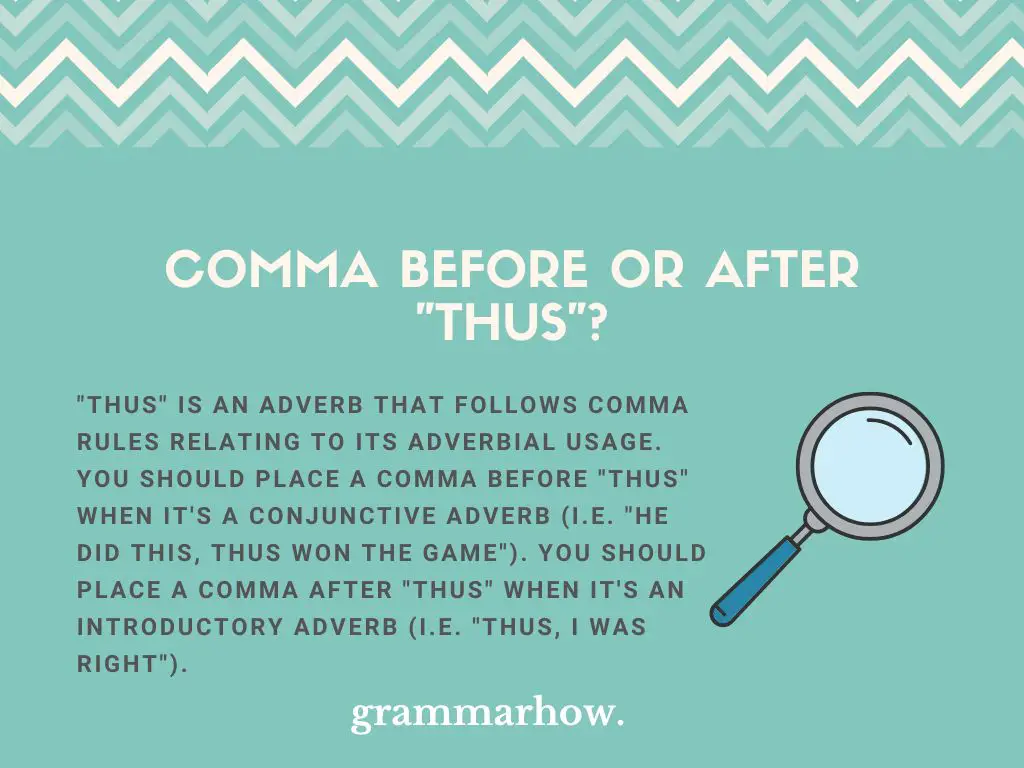You might not be coming across “thus” as frequently anymore. After all, we’re not in the Shakespearian era. However, it’s still good to learn how to punctuate it. Thus, this article will explore where to place the comma around “thus” in your writing.
Comma Before or After “Thus”?
“Thus” is an adverb that follows comma rules relating to its adverbial usage. You should place a comma before “thus” when it’s a conjunctive adverb (i.e. “he did this, thus won the game”). You should place a comma after “thus” when it’s an introductory adverb (i.e. “Thus, I was right”).

KEY TAKEAWAYS
- Commas come before when “thus” is a conjunctive adverb combining two clauses.
- Commas come after when “thus” starts a sentence.
- No comma is needed when “thus” modifies verbs and adjectives, e.g. “thus far”.
These examples will show you the main ways to place a comma before “thus” in the middle of a sentence:
- She could have been there for him, thus resulting in different situations.
- I won the fight, thus becoming champion all alone.
Here, “thus” is a conjunctive adverb. It joins two clauses to create a longer clause showing a cause and effect created by “thus.”
You might also benefit from checking out how to place a comma after “thus” at the beginning of a sentence:
- I did not help here with it. Thus, she managed to mess up the whole project.
- We did all that we could. Thus, we determined this wasn’t the solution.
Here, “thus” starts a new sentence. It’s an introductory clause when written like this. It’s still a conjunctive adverb but does not join the previous sentence to a new one because the new sentence is an independent clause.
It’s also possible to place a comma before “and thus,” which is a variation of “thus:”
- I did not help here, and thus I got punished.
Here, “and” is the conjunction, and “thus” does not require a comma directly before it.
The Chicago Manual of Style and the AP Stylebook both teach us about comma placement for adverbs like “thus.” With adverbs, you should offset them with a comma when they are introducing new clauses or combining two different clauses.
When to Place a Comma Before “Thus”
You can place a comma before “thus” when it’s joining two clauses. It’s not always necessary to do this as it’s not the most common usage for “thus.”
“Thus” is a conjunctive adverb. You can include it between two clauses when you are introducing a dependent or relative clause to an independent clause.
Here’s how you might see that work:
- I did not get the trophy, thus becoming the next loser.
Here, “thus” introduces a dependent clause. “Becoming the next loser” is not grammatically correct as its own sentence. Instead, it adds information to the independent clause “I did not get the trophy.”
You may remove the “thus” sentence and find that it still makes sense:
- I did not get the trophy.
This is how to confirm whether a comma should come before “thus.” If you can remove “thus” and the rest of the clause and the sentence is still correct, you know there should be a comma before it.
When to Place a Comma After “Thus”
There are a few situations where you might place a comma after “thus.”
It’s most common to place a comma after “thus” when it’s an introductory adverb. You can offset “thus” from the rest of the sentence by placing a comma directly after it. This allows “thus” to modify the sentence as a whole.
- I did not get the reward. Thus, I took it upon myself to do whatever I needed.
- She thought about the answer. Thus, she gave the one she thought was most appropriate.
“Thus” is a conjunctive adverb rather than a conjunction. It cannot link two independent clauses. To account for this, you must instead use a period or semi-colon before “thus” when trying to connect an independent clause with the previous statement.
You may also find a comma after “thus” in the middle of a sentence. This occurs when “thus” comes after a semi-colon rather than a period.
Here’s how it works with a semi-colon:
- I did not win; thus, I had to take the loss.
You may also include vocative commas after “thus” when you want to encourage the reader to take a breath for emphasis:
- I did not think about it and, thus, made the problem much worse.
When to Use “Thus” Without a Comma
You don’t always need a comma when using “thus.”
“Thus” is an adverb, meaning it can modify verbs and adjectives. When modifying other words directly, no commas are needed.
- While she was thus engaged, he made his move on the building.
“Thus far” as a phrase is one of the most common ways to see “thus” without any commas. You can include “thus far” when something is true at this moment in time but may be liable to change.
- There have been no reports thus far of you in any trouble.
- I could have spoken to them, but there has been no change thus far.

Martin holds a Master’s degree in Finance and International Business. He has six years of experience in professional communication with clients, executives, and colleagues. Furthermore, he has teaching experience from Aarhus University. Martin has been featured as an expert in communication and teaching on Forbes and Shopify. Read more about Martin here.
